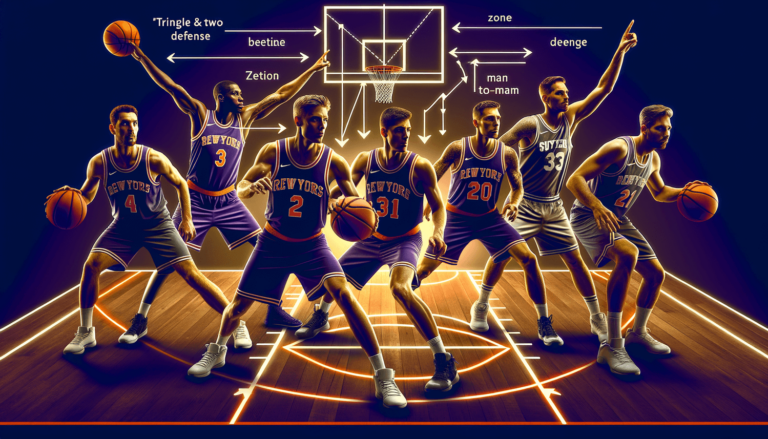
What’s a Triangle and Two Defense in Basketball?
Written by: Basketball Universe
Last updated:

For those intrigued by the strategic intricacies of basketball, look no further! In this post, we’re diving headfirst into the world of the triangle and two defense – an unconventional hybrid system that can befuddle even the savviest of offenses. An optimal balance of both fun and professional insights, this one-stop guide on the triangle and two defense will lay down the foundations, intricacies, and fascinating applications of this unique basketball scheme. Get ready, dear hoop enthusiasts, as our journey through the enigmatic realm of the triangle and two defense is about to begin!
What’s a Triangle and Two Defense in Basketball?
The triangle and two defense is a hybrid basketball strategy that involves three players forming a triangle zone defense while the other two players match up in man-to-man defense against the opposing team’s best offensive players. This tactic aims to disrupt the offensive flow, limiting the scoring options and challenging the other team to adapt.
Unlocking the Principles of the Triangle and Two Defense
Basketball, as we all know and love, is a dynamic and ever-evolving sport that requires an equally adaptable mindset from its players and coaches. One of the more interesting defensive systems that have emerged is the triangle and two defense. Let’s delve deeper into understanding its unique principles and potential advantages when facing formidable offenses.
The Fundamentals: Zone and Man-to-Man Defense
To fully grasp the intricacies of the triangle and two defense, it’s essential to comprehend its two core components: zone and man-to-man defense. Zone defense is a defensive strategy where players are responsible for guarding specific areas on the court rather than specific opponents. Conversely, man-to-man defense requires each defender to exclusively cover one opponent on the court.
The Inner Workings of the Triangle and Two Defense
Now that we have a basic understanding of its foundations, let’s break down the strategic elements of the triangle and two defense. As the name suggests, this defense is based on a triangular formation, along with an added layer of man-to-man coverage.
Establishing the Triangle
The triangle begins with one player (usually a taller player) positioned under the basket, while two other players (typically guards) are situated on the wings on the free-throw line extended. The player under the basket guards the low post and baseline areas, whereas the two wing players are responsible for covering the elbows and corners. Together, these three players form an imaginary triangle as they execute the zone defense duties.
The Two-Man Lockdown
The remaining two players are tasked with man-to-man responsibilities, focusing on the opposing team’s top offensive threats. These defenders stay connected to their respective marks across the court, determined to deny any scoring opportunities. The goal is to limit the impact of the other team’s star players and force less proficient players to carry the offensive burden.
Making the Triangle and Two Defense Work
Having dissected the components of the triangle and two defense, now it is time to discuss strategies and best practices to make this defensive scheme effective during a basketball game.
Team Communication
As with any defensive system, communication is imperative for the success of the triangle and two defense. The three players forming the triangle must consistently relay information to one another about the location and movement of opposing players. The defenders in man-to-man coverage likewise need to stay connected, understanding when and where to switch or help if necessary. Effective communication is a prerequisite for any defense to thrive, and the triangle and two is no exception.
Quick Adaptation
Since the triangle and two defense is a hybrid system that can be unfamiliar to some opponents, the ability to adapt quickly is crucial. When the offense identifies the triangle and two, they may attempt to exploit its weaknesses or shuffle their offensive lineup. Being able to switch back to a traditional man-to-man or zone defense when needed is a valuable tool in keeping the opposing team guessing.
Identifying the Right Moments
Knowing when to deploy the triangle and two defense is also essential. This scheme is typically most effective against teams with one or two dominant scorers and less potent offensive options. Applying the triangle and two against a team with balanced scoring can lead to defensive breakdowns and make it easier for the offense to find the open man. As a situational defense, the triangle and two requires foresight and precise timing to maximize its effectiveness.
Strengths and Limitations of the Triangle and Two Defense
As with any defensive system, the triangle and two has its strengths and limitations. Weighing them against each other allows teams to decide whether this scheme is the right tool to use against a specific opponent or during certain situations.
Strengths
- Disrupts offensive rhythm: The triangle and two can throw off the opponent’s offensive rhythm and force them to adjust their game plan, giving you a psychological advantage during the match.
- Neutralizes top scorers: By assigning dedicated defenders to cover the opposing team’s best offensive players, the triangle and two aims to suppress their scoring opportunities, compelling secondary scorers to take over the offensive burden.
- Flexibility: The ability to switch between the triangle and two defense and other defensive systems adds another layer of complexity for the opponent, complicating their offensive decision-making.
Limitations
- Requires strong individual defenders: The triangle and two relies heavily on the two-man coverage being able to effectively shut down their individual assignments. This requires athletic, versatile, and skilled defenders to execute successfully.
- Rebound vulnerability: With only one player covering the low post in the triangle, the defense can be exposed to offensive rebounds if the opponent crashes the boards.
- Less efficient against balanced scoring teams: Against well-balanced offenses with multiple scoring threats, the triangle and two may not provide the desired results, as it primarily focuses on limiting the impact of the top two scorers.
Famous Examples of the Triangle and Two Defense in Action
Though not extensively used, the triangle and two defense has had its moments of glory in the basketball world. Let’s take a look at some notable examples of when this strategy was effectively employed.
1984 NBA Finals: Boston Celtics vs. Los Angeles Lakers
In Game 7 of the 1984 NBA Finals, Boston Celtics coach KC Jones utilized the triangle and two defense as a surprise tactic to contest Magic Johnson and Kareem Abdul-Jabbar. The move limited the Lakers’ offense and proved to be a vital factor in the Celtics claiming their 15th NBA Championship.
2012 NCAA Men’s Basketball Championship: Kansas vs. Kentucky
The Kansas Jayhawks turned to the triangle and two defense in a desperate bid to mount a comeback against the Kentucky Wildcats in the NCAA Championship game. While it helped them claw back into the game, the Wildcats’ depth ultimately secured their victory. Nevertheless, the triangle and two offered a glimpse of its potency in vital moments.
Developing the Skills for the Triangle and Two Defense
While understanding the principles and strategies behind the triangle and two defense is crucial, it’s equally important for players to develop the skills required to execute this defensive scheme effectively. Here are a few areas to focus on:
On-Ball Defense
Both defenders in man-to-man coverage must be proficient in on-ball defense, capable of staying in front of their opponent, and contesting shots without fouling. On-ball defensive drills and mastering proper footwork are essential for players taking on this role.
Off-Ball Defense
Off-ball defense is a critical aspect of both the triangle and the man-to-man coverage elements of this scheme. Defenders must learn to maintain their position while maintaining awareness of both the ball and their assigned player, ensuring they can react quickly to any offensive movement or changes.
Communication Skills
Lastly, as emphasized earlier, effective communication skills are indispensable for executing the triangle and two defense. Teams should always practice their communication during drills, scrimmages, and games, ensuring that everyone stays connected and engaged throughout the defensive possessions.
In conclusion, the triangle and two defense is a unique and fascinating aspect of basketball that can provide teams with an unconventional method to fluster their opponents. By understanding its foundations, intricacies, and potential applications, players and coaches alike can broaden their defensive arsenal and maintain the element of surprise to create game-changing moments on the court.
Additional Considerations for the Triangle and Two Defense
Delving beyond the traditional analyses of the triangle and two defense, there are other factors worth considering to enhance its overall potential. By exploring complementary defensive strategies, focusing on player development, and understanding when to make the switch, coaches can tap into the full potential of this unconventional defensive tactic.
Incorporating Complementary Strategies
Pairing the triangle and two defense with other supporting strategies may further stifle the opponent’s offense. For instance, trapping or double-teaming the primary ball handler as they approach the triangle may force them into making a difficult pass or taking a contested shot. Additionally, integrating the switch defense within the triangle setup can help maintain defensive balance in the event of quick ball reversals or pick-and-roll actions.
Developing Versatile Defenders
To maximize the effectiveness of the triangle and two defense, it is crucial to develop players who can excel in both zone and man-to-man coverage. Teams that focus on building well-rounded defenders will have an easier time seamlessly transitioning between different defensive schemes, presenting a more fluid and adaptable approach to game situations. Practicing various game scenarios and incorporating regular two-way drills can reinforce the adaptability and responsiveness of defenders.
Switching Between Defensive Schemes
While the triangle and two defense can create a defensive edge, its effectiveness depends on its novelty and unpredictability. Therefore, being able to switch between the triangle and two and other defensive systems during a game is invaluable. Timing these transitions well can catch the opposing team off guard and exploit their hesitancy. One such method is to alternate defensive schemes after each timeout, or when a specific lineup change occurs, adding another layer of complexity to your tactical approach.
Conducting Drills for the Triangle and Two Defense
To help players better understand and internalize the principles of the triangle and two defense, coaches can incorporate dedicated drills into practice sessions. These drills should focus on developing the necessary skills and instincts for the different roles within this defensive configuration.
Three-on-Three Triangle Drills
One simple yet effective way to reinforce the concepts of the triangle zone defense is to have players go through a three-on-three drill, exclusively focusing on the roles within the triangular formation. This allows players to develop an understanding of their zone responsibilities, improve their off-ball positioning, and practice communicating with their teammates. Coaches can utilize various offensive setups to replicate game-like situations and help defenders adapt to different challenges.
Two-on-Two Man-to-Man Drills
Focusing on the two players tasked with man-to-man coverage, these drills should emphasize on-ball defense, maintaining the proper defensive stance, and applying pressure without fouling. Off-ball defenders need to work on denying passes, staying connected with their assigned player, and reacting to screens and other offensive actions. With multiple reps and practice, players will develop the confidence and skill set to lock down their individual matchups.
Five-on-Five Scrimmages with Triangle and Two Defense
Although the separate drills sharpen individual aspects of the triangle and two defense, incorporating the full scheme into five-on-five scrimmages will provide the most holistic and practical training. By executing the triangle and two defense in a game-like setting, players will form a comprehensive understanding of their roles and responsibilities while reinforcing communication and teamwork. Coaches can modify the scrimmage conditions to present various challenges and encourage adaptability from the defenders.
With these additional sections providing even deeper insights and practice techniques for the triangle and two defense, both players and coaches can unlock the full potential of this fascinating and unconventional system to create exciting game-changing moments on the court.
Frequently Asked Questions (FAQ)
In this FAQ section, we have collected thirteen common questions and concise answers to help clarify any uncertainties about the triangle and two defense. These question-and-answer pairs address various aspects of this defensive system, from its essential elements to its practical implementations and limitations.
1. What is the purpose of the triangle and two defense in basketball?
The triangle and two defense is designed to disrupt the opposing team’s offensive rhythm by mixing zone and man-to-man defensive principles, neutralizing their top scorers, and forcing less proficient players to take on the offensive burden.
2. How is the triangle and two defense different from a standard zone or man-to-man defense?
While traditional zone defense assigns players to cover specific areas on the court, and man-to-man defense assigns players to individual opponents, the triangle and two defense combines both elements, featuring a triangular zone formation and two dedicated man-to-man markers for the opposing team’s best scorers.
3. When should a team use the triangle and two defense?
The triangle and two defense is most effective against teams with one or two dominant scorers and limited secondary scoring options. Being a situational defense, it’s crucial to use it strategically and sporadically to maintain the element of surprise.
4. What are the key strengths of the triangle and two defense?
Some strengths of the triangle and two defense include disrupting offensive rhythm, neutralizing top scorers, and providing defensive flexibility by seamlessly switching between different defensive schemes.
5. What are the potential limitations of the triangle and two defense?
The triangle and two defense can be less effective against well-balanced scoring teams, vulnerable to offensive rebounds, and heavily reliant on strong individual defenders for the man-to-man coverage.
6. How can players develop the skills necessary for the triangle and two defense?
Players can hone their on-ball and off-ball defense, improve communication skills, and participate in a mix of three-on-three, two-on-two, and five-on-five drills tailored to reinforce the principles of triangle and two defense.
7. Can the triangle and two defense be used alongside other defensive strategies?
Yes, incorporating complementary strategies such as trapping, double-teaming, and switching within the triangle setup can create a more dynamic and unpredictable defensive approach.
8. Is the triangle and two defense effective at all levels of basketball competition?
The triangle and two defense can be effective at various levels of competition, from youth leagues to professional games. However, its effectiveness depends on the specific matchups, players’ skill levels, and coaching strategy.
9. How can a team adapt when the opposing team identifies the triangle and two defense during a game?
Teams can maintain unpredictability by quickly switching between the triangle and two and other standard defensive systems during a game, catching the opponent off-guard and disrupting their offensive adjustments.
10. How does the triangle and two defense handle pick-and-roll situations?
The two man-to-man defenders need to effectively communicate and execute switches or help defense, while the triangle zone defenders must maintain awareness and be prepared to provide additional support when necessary.
11. How can a team exploit the weaknesses of an opponent running the triangle and two defense?
To exploit the triangle and two defense, teams can rely on balanced scoring from multiple players, force defensive rotations with quick ball reversals, and crash the offensive boards to capitalize on potential rebounding vulnerabilities.
12. How does the triangle and two defense fare against three-point shooting teams?
Although the triangle and two can limit the top scorers from beyond the arc, the defense relies heavily on the quality of the individual defenders and the responsiveness of the zone players when contesting perimeter shooters.
13. Are there any other hybrid defenses similar to the triangle and two?
Yes, the box-and-one defense is another hybrid system that combines zone and man-to-man principles. In this case, four defenders form a box-shaped zone, while one player is assigned to cover the opponent’s primary scorer in man-to-man coverage.
Featured Posts
- No pillar pages found.





